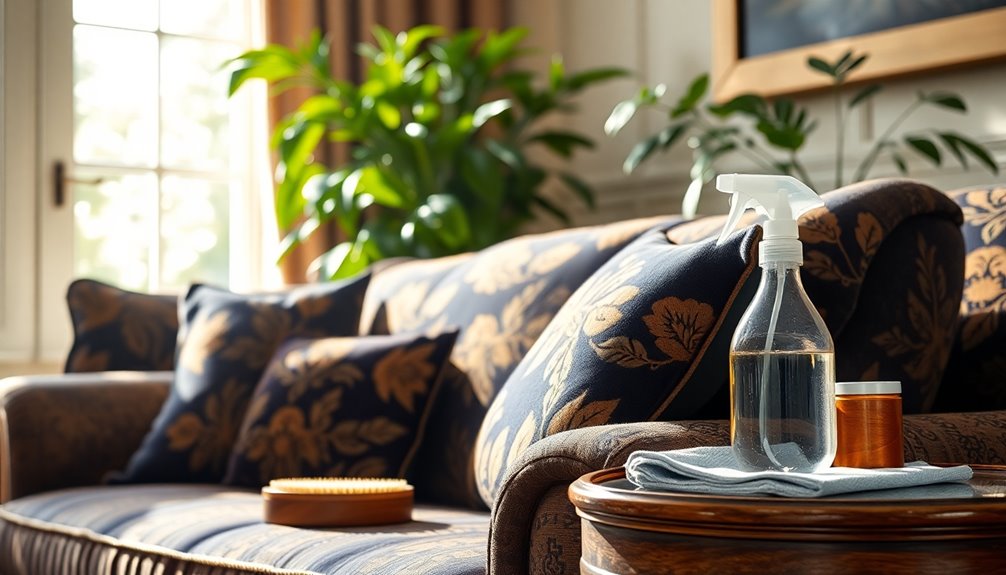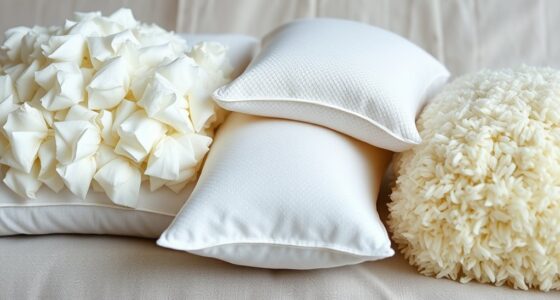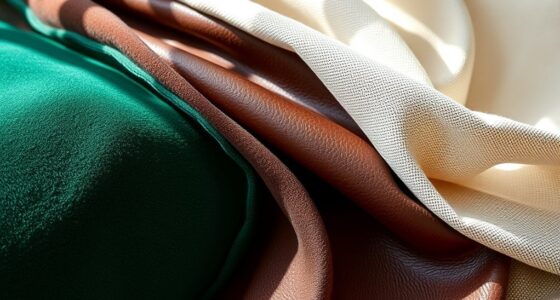To care for your upholstery and keep it looking fresh, you should regularly vacuum with a soft brush attachment to remove dust and debris. Immediately blot any spills with a clean cloth to prevent staining. For deeper stains, mix dish soap, warm water, and vinegar, then gently scrub the area. Apply fabric protectors to help resist stains and consider using slipcovers in high-traffic areas. Schedule a thorough cleaning every six months for optimal maintenance. By following these tips, you'll not only enhance the appearance of your furniture but also learn effective strategies for long-term care.
Key Takeaways
- Regularly vacuum upholstery with a soft brush attachment to remove dust and debris, preventing dirt buildup.
- Blot spills immediately with a clean cloth and use mild water-based cleaners for spot treatment.
- Apply fabric protectors and choose stain-resistant fabrics to enhance durability and prevent stains.
- Schedule deep cleanings every six months using gentle cleaning solutions and ensure thorough drying.
- Minimize sunlight exposure and avoid dark-colored blankets to prevent fading and dye transfer.
General Upholstery Maintenance

When you prioritize general upholstery maintenance, you not only keep your furniture looking fresh but also extend its lifespan.
Start by vacuuming your upholstery weekly with a soft brush attachment to remove dust and debris gently. This simple step prevents dirt buildup and reduces allergens in your home.
If spills occur, act immediately by blotting with a clean cloth to prevent stains from setting. Use a mild, water-based cleaner for spot treatment, avoiding over-wetting. Additionally, be aware that regular vacuuming helps maintain the integrity of your upholstery.
Additionally, consider applying fabric protection like waterproofing sprays or natural solutions to create a barrier against dirt and stains.
Regular maintenance not only preserves the appearance of your upholstery but also ensures it remains a comfortable and welcoming part of your home.
Effective Cleaning Techniques
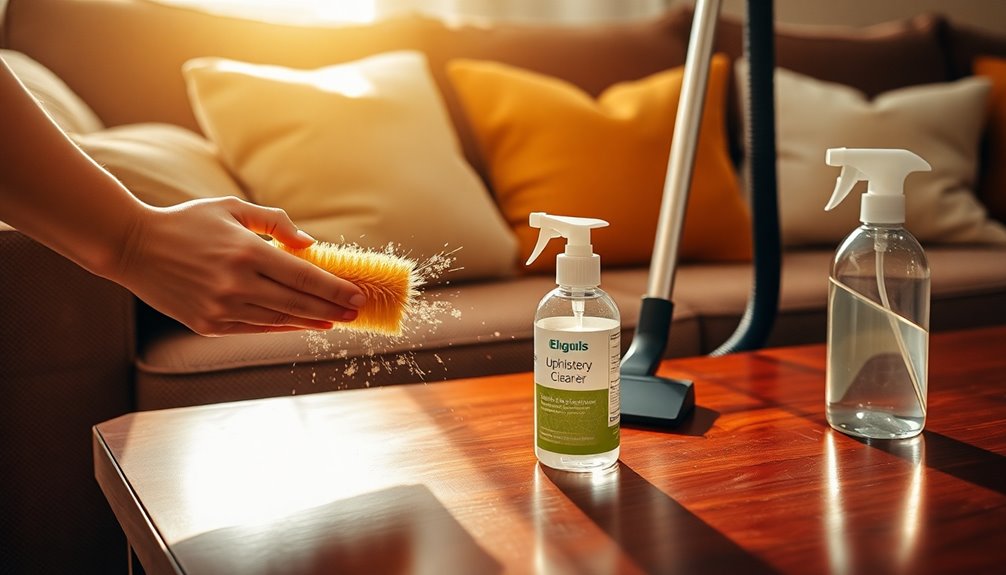
Maintaining your upholstery involves more than just regular upkeep; knowing how to clean effectively can make a significant difference in preserving its appearance. Regular maintenance prevents long-term damage and enhances the visual appeal of living spaces.
Start by vacuuming with a soft brush attachment to remove dirt and pet hair. Check for stains and gather your cleaning tools, ensuring good ventilation in the area.
For spills, blot with a clean cloth to absorb liquid, then sprinkle baking soda on grease marks to draw it out.
Mix a cleaning solution of dish soap and warm water, adding vinegar for tougher stains. Use a sponge to gently rub the stain, rinsing with clear water afterward.
Always blot instead of rubbing to avoid damaging the fabric, and repeat these steps as needed until the stains fade.
Deep Cleaning Methods
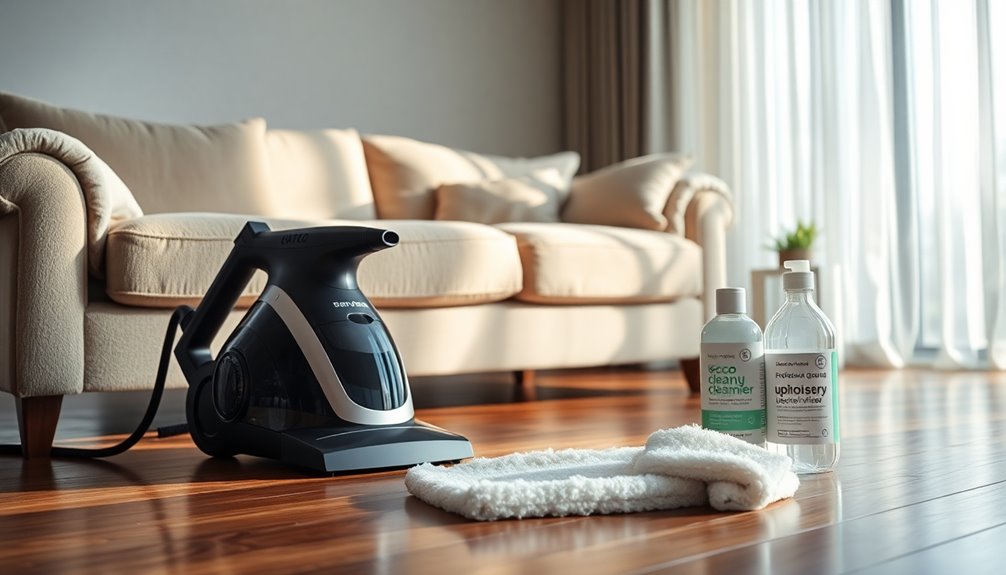
Deep cleaning your upholstery is essential for maintaining its freshness and longevity, especially if you have kids or pets.
Start by gathering your tools: a vacuum with an upholstery attachment, mild cleaning solutions, and proper ventilation equipment.
First, vacuum thoroughly and sprinkle baking soda to absorb odors. Address any stains immediately by blotting them with a clean microfiber cloth.
For a DIY clean, mix warm water with mild shampoo and scrub gently. Additionally, regular cleaning can help prevent health issues related to poor indoor air quality. Alternatively, consider hiring professionals who use specialized equipment for deeper cleaning.
Remember to ensure your upholstery dries completely, and regularly maintain it by reapplying protectors and scheduling cleanings every six months.
With these methods, you can keep your upholstery looking and feeling great.
Stain Prevention Strategies
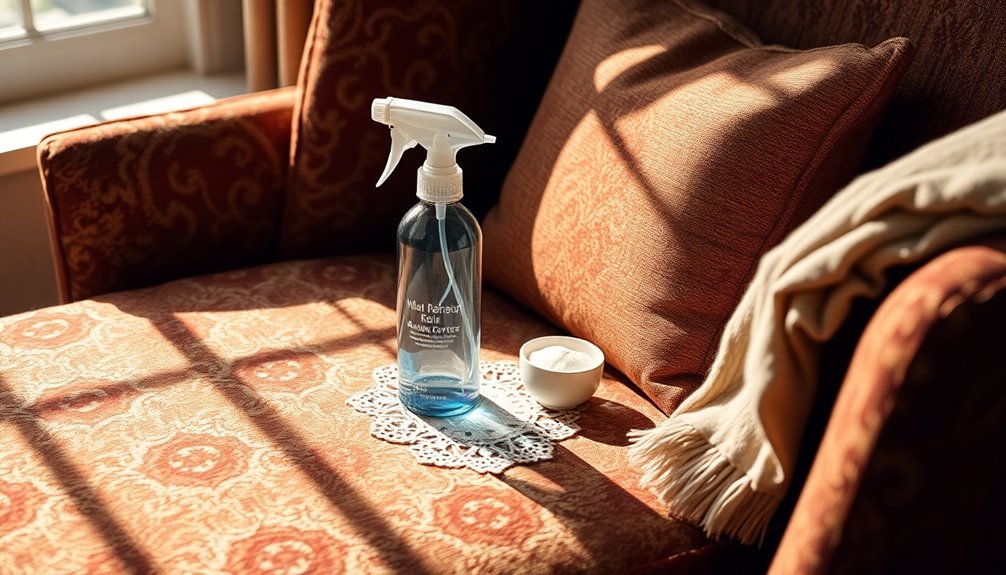
Stains can ruin your upholstery, but with effective prevention strategies, you can keep your furniture looking its best.
Start by applying fabric protectors to create a barrier against spills. Opt for stain-resistant fabrics like Crypton or microfiber, and consider pre-treating your upholstery for added protection. Additionally, applying a stain protection treatment can significantly enhance the longevity of your upholstery.
To avoid spills altogether, designate eating areas and train pets to stay off the furniture. Using slipcovers or throws can also shield high-traffic areas.
Regular maintenance is crucial—vacuum often, inspect for wear, and promptly address any stains you find.
Upholstery Protection Tips
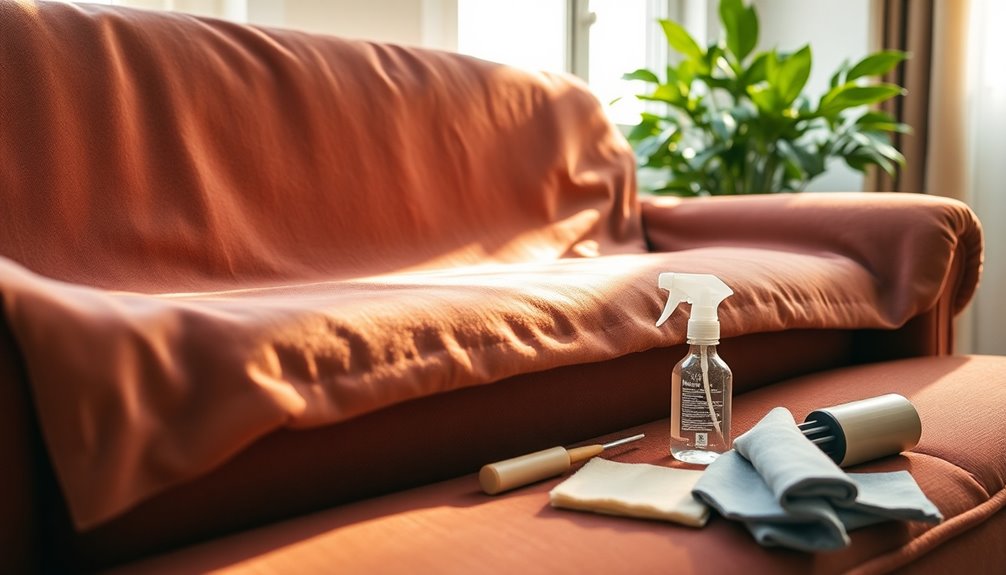
Keeping your upholstery in top shape goes beyond just preventing stains; it also involves proactive protection measures.
Start by applying stain repellents and waterproofing sprays, especially in high-moisture areas or homes with kids and pets. Commercial fabric protectors like Scotchgard form an invisible barrier against dirt and stains, but always check compatibility with your fabric.
Regular maintenance is key—vacuum frequently, brush cushions, and remove dust and debris. Avoid dark-colored blankets, which can transfer dye, and arrange your space to minimize sunlight exposure that causes fading. Additionally, implementing an upholstery protection plan is crucial for maintaining the longevity of your furniture.
Lastly, consider professional cleaning for deep maintenance and choose the right stain remover based on fabric type. These steps will help ensure your upholstery remains beautiful and lasting.
Frequently Asked Questions
How Often Should I Vacuum My Upholstery?
You should vacuum your upholstery based on how much it gets used.
If you've got pets or kids, aim for daily vacuuming to keep dirt and allergens at bay.
For most households, twice a week works well, while weekly vacuuming is the bare minimum for less-used areas.
Remember to use the right attachments and settings to protect your fabrics, and always test your vacuum on a hidden spot first.
Can I Use Bleach on Upholstery?
You can use bleach on upholstery, but proceed with caution.
Always test a small, hidden area first to check for damage. If the fabric is bleach-safe, dilute it with water in a 1:10 ratio.
Apply the solution gently, avoiding scrubbing, and ensure good ventilation.
Remember, bleach can weaken fibers over time, so only use it when absolutely necessary.
Protect surrounding areas to prevent accidental damage while cleaning.
What Types of Fabrics Are Easiest to Maintain?
Imagine your home as a bustling marketplace, where chaos reigns. In this vibrant setting, synthetic fabrics like microfiber and vinyl stand tall as your loyal guardians.
They resist stains, repel pet hair, and demand minimal upkeep, making them perfect for your busy life. Leather, too, offers durability and elegance, easily wiped clean.
These materials keep your sanctuary inviting, allowing you to focus on enjoying life rather than worrying about spills and messes.
How Do I Remove Pet Hair From Upholstery?
To remove pet hair from upholstery, you've got several effective options.
Start with a lint roller; it's quick and collects hair easily.
Vacuuming with a pet hair attachment is another great choice, especially for deeper cleaning.
If you have rubber gloves, try lightly dampening them and running your hands over the fabric to gather hair.
Specialized brushes and even a squeegee can also work wonders for stubborn strands.
Just choose what suits you best!
Is Professional Cleaning Worth the Cost?
When you consider professional cleaning, it's important to weigh the benefits against the costs.
While it might set you back $100 to $250, you'll get a deep clean that removes allergens and protects your furniture.
DIY cleaning can save money, but it often falls short in effectiveness.
If you value your time and want optimal results, investing in professional cleaning is usually worth it for the health of your family and the longevity of your upholstery.
Conclusion
In the world of upholstery care, a little effort goes a long way. Remember, "an ounce of prevention is worth a pound of cure." By following these maintenance tips and cleaning techniques, you can keep your furniture looking fresh and inviting for years to come. Stay proactive with stain prevention and protection strategies, and you'll enjoy your upholstery without the worry of wear and tear. So, roll up your sleeves and give your furniture the love it deserves!
